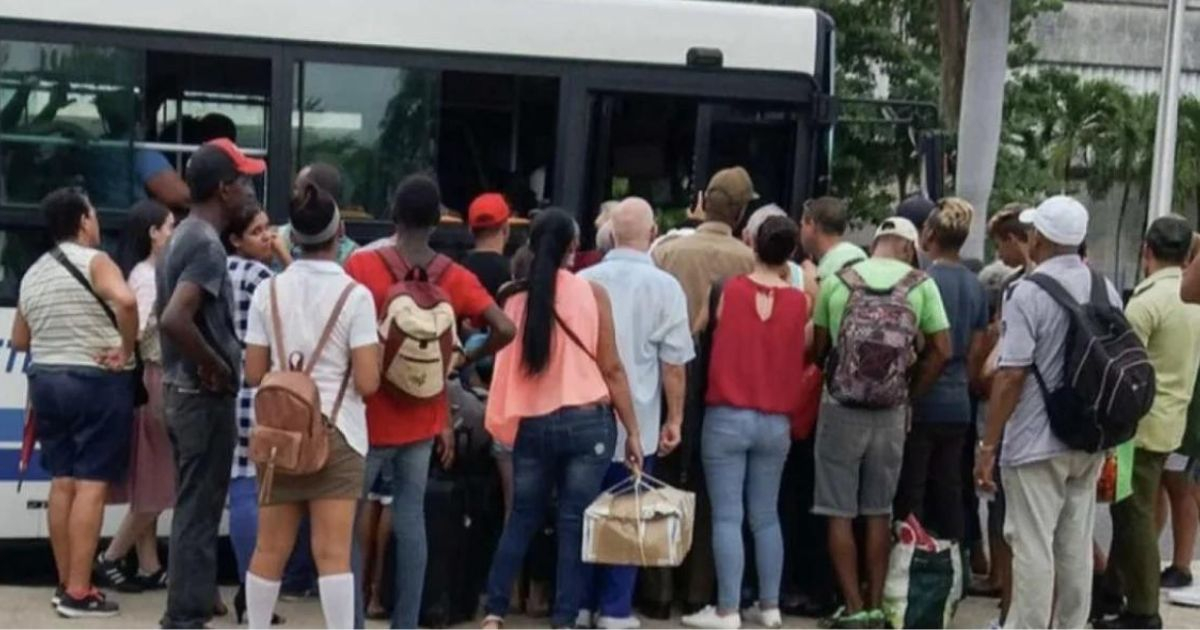The crisis in public transportation in Santiago de Cuba, evidenced by large crowds at bus stops at any time of day, has forced the local government to take a desperate measure: compelling drivers of state-owned companies to transport the population during peak demand hours.
Noralquis Guerra Guevara, director of the Unidad Empresarial Terminales y Medios Alternativos de Santiago de Cuba, reported that 110 units in the region are participating in "solidarity transportation" with their vehicles, according to the official newspaper Sierra Maestra. However, the director warned that of the total entities that could alleviate the crisis with their vehicles, "3% have not joined this activity due to a deficit in their available automotive fleet," another undeniable sign of the transportation precariousness in the province.
Moreover, she denounced that not all drivers are participating in "solidarity transportation," noting that some do not stop at the pickup points. She pointed out that the companies involved provide their vehicles from 6:30 am to 8:30 am and in the afternoon from 4:00 pm to 5:30 pm, coinciding with the times when the transportation crisis in Santiago de Cuba is most evident.
Although the director advocated for "solidarity transportation" to be done "consciously," she threatened drivers with the placement of inspectors at the points of greatest concentration of people. According to the official newspaper, an "organizer" will be present at each "solidarity transportation" point to "organize and control."
Rogelio Samada Rubio, provincial deputy director of transportation in Santiago de Cuba, instructed that the issue of "solidarity transportation" be discussed in the morning meetings of state entities. According to him, this is the way to get drivers to cooperate consciously.
Due to the regime's inability to solve the transportation crisis in Santiago de Cuba, the official admitted that they have had to resort to leased buses. Samada acknowledged that the lack of fuel exacerbates mobility problems, noting that some vehicles, although operational, cannot go out on the streets due to the fuel shortage.
The official reminded that the resolution 435 from 2002, from the Ministry of Transportation, mandates that state-owned vehicles, on their return route, are obligated to support transportation. Despite the existence of this legal instrument, the mobilization of "organizers" and inspectors at the "solidarity transportation" points, Samada admitted that drivers are still seen on the streets without carrying any passengers, a sign of the regime's inefficient management.
"In case of non-compliance, a daily analysis and a weekly summary are conducted with the vice-governor of all drivers who negatively impact, and measures are applied, which can include the permanent dismissal of the driver who repeatedly fails to comply," he emphasized.
However, the transportation issue is repeated in all cities across the country. In Cuba, public transportation mobility is critical, and this can be confirmed by the numbers of buses currently operating in the capital: 252 units, according to official figures, a number below the 309 buses that remain out of service.
This was revealed last March during a balance sheet of the Ministry of Transportation (Mitrans), where Yunier de la Rosa Hernández, general director of Havana Transportation, described the situation in that territory as "complex."
In May, the Minister of Transportation of Cuba, Eduardo Rodríguez Dávila, acknowledged the poor service the government offers to those who need to travel to the Isle of Youth. In a text shared on his Facebook profile, Rodríguez Dávila admitted that the process is extremely uncomfortable and cumbersome, from purchasing the ticket to arrival.
Santiago de Cuba Transportation Crisis: Key Questions Answered
The transportation crisis in Santiago de Cuba has led to significant measures by the local government. Here are some key questions and answers to help understand the situation better.
Why are state-employed drivers being compelled to transport passengers?
The local government has taken this desperate measure due to the severe public transportation crisis, evidenced by large crowds at bus stops at any time of day.
How many state units are involved in solidarity transportation?
According to Noralquis Guerra Guevara, 110 units in Santiago de Cuba are participating in the initiative, using their vehicles to help alleviate the crisis.
What are the challenges facing the solidarity transportation initiative?
Challenges include a small percentage of entities not participating due to vehicle shortages, some drivers not stopping at pickup points, and the exacerbation of mobility issues due to fuel scarcity.
What legal framework supports the use of state vehicles for public transportation?
Resolution 435 from 2002 by the Ministry of Transportation mandates that state-owned vehicles must support transportation during their return routes.
